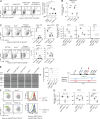Identification of embryonic precursor cells that differentiate into thymic epithelial cells expressing autoimmune regulator
- PMID: 27401343
- PMCID: PMC4986530
- DOI: 10.1084/jem.20151780
Identification of embryonic precursor cells that differentiate into thymic epithelial cells expressing autoimmune regulator
Abstract
Medullary thymic epithelial cells (mTECs) expressing autoimmune regulator (Aire) are critical for preventing the onset of autoimmunity. However, the differentiation program of Aire-expressing mTECs (Aire(+) mTECs) is unclear. Here, we describe novel embryonic precursors of Aire(+) mTECs. We found the candidate precursors of Aire(+) mTECs (pMECs) by monitoring the expression of receptor activator of nuclear factor-κB (RANK), which is required for Aire(+) mTEC differentiation. pMECs unexpectedly expressed cortical TEC molecules in addition to the mTEC markers UEA-1 ligand and RANK and differentiated into mTECs in reaggregation thymic organ culture. Introduction of pMECs in the embryonic thymus permitted long-term maintenance of Aire(+) mTECs and efficiently suppressed the onset of autoimmunity induced by Aire(+) mTEC deficiency. Mechanistically, pMECs differentiated into Aire(+) mTECs by tumor necrosis factor receptor-associated factor 6-dependent RANK signaling. Moreover, nonclassical nuclear factor-κB activation triggered by RANK and lymphotoxin-β receptor signaling promoted pMEC induction from progenitors exhibiting lower RANK expression and higher CD24 expression. Thus, our findings identified two novel stages in the differentiation program of Aire(+) mTECs.
© 2016 Akiyama et al.
Figures








References
-
- Akiyama N., Shinzawa M., Miyauchi M., Yanai H., Tateishi R., Shimo Y., Ohshima D., Matsuo K., Sasaki I., Hoshino K., et al. . 2014. Limitation of immune tolerance-inducing thymic epithelial cell development by Spi-B-mediated negative feedback regulation. J. Exp. Med. 211:2425–2438. 10.1084/jem.20141207 - DOI - PMC - PubMed
-
- Akiyama T., Shimo Y., Yanai H., Qin J., Ohshima D., Maruyama Y., Asaumi Y., Kitazawa J., Takayanagi H., Penninger J.M., et al. . 2008. The tumor necrosis factor family receptors RANK and CD40 cooperatively establish the thymic medullary microenvironment and self-tolerance. Immunity. 29:423–437. 10.1016/j.immuni.2008.06.015 - DOI - PubMed
Publication types
MeSH terms
Substances
LinkOut - more resources
Full Text Sources
Other Literature Sources
Molecular Biology Databases

